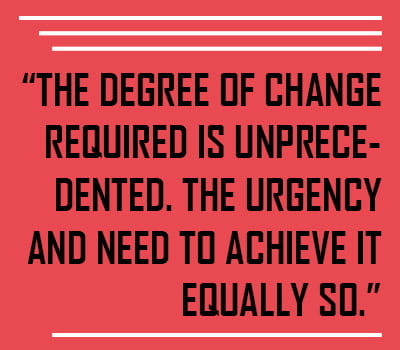The Active Building Centre was created in 2019 to drive transformation in the way the UK designs, constructs and operates buildings. Keith has more than 40 years’ experience implementing major public infrastructure and city developments, through either design, construction or public policy input. He has also successfully run several major construction businesses, including engineering consultancy Atkins and global contractor Kvaerner (later Skanska).
As chairman of sustainability charity Forum for the Future, and a member of the advisory board at the Environmental Change Institute at Oxford University, Keith is a passionate advocate for sustainable development, the need to de-carbonise society, and the role that businesses must play in engineering and driving that change.
As the population increases, what investment in infrastructure is needed?
“More than 50% of the world’s population is now urban, and it is forecast to continue to grow towards 70% (of an even larger population) by 2050. It is a scary prospect, and something that requires our attention right now.
“If we are to accommodate this global population growth, investment in new infrastructure is vital. Alone, the infrastructure defined as utilities – the assets underpinning our energy generation and supply, our water and wastewater, our data and communications, transportation and ecological systems – will require investment of a staggering $47 trillion by 2050.
“That is a massive sum, and a massive challenge, not least as it comes on top of investment to provide and maintain the inevitable new buildings and social infrastructure – such as hospitals and schools – required to run a new urbanised society.
“In effect, we are facing the reality of having to design and construct urban and inter-urban infrastructure on an enormous scale – several times what currently exists in the whole of Europe – in just 20 years.
“This presents a huge challenge and, on the face of it, a fantastic opportunity for our design and construction industry – and doubtless the associated financiers and lawyers – as we rush to construct the modern living conditions required to meet this growth.
“All good and well if the story ended there. But, of course, it doesn’t.
“Because, at the same time, we are also wrestling with the need to adapt to a changing climate, and to enhance our existing infrastructure to be resilient against more and more frequent, and increasingly extreme, weather events. That means meeting rising sea levels with higher defences; meeting hotter conditions with more air conditioning systems; meeting water shortage with bigger water storage and desalination solutions.
“In effect, faced with the twin challenges of rising population and climate change, our natural ability and desire to adapt and problem solve means that we are now creating even bigger problems. We are on a path that ignores the macro picture and simply sees the same industry tackling the same questions in a bigger market, with bigger solutions and even bigger margins. Which is fine is you can afford the solution; less than ideal if you cannot.

“The science is clear and unequivocal. To keep climate change impact to vaguely tolerable levels, it is imperative to limit the average global warming to 1.5oc. That means transforming all economies to net zero carbon by 2050. Mitigation is different from adaptation. It requires a transformation of our economies to be not only fossil-fuel free but to have geo-engineering developed and working. It means that infrastructure professionals have to think differently – not just bigger – about the solution.
“The degree of change required is unprecedented. The urgency and need to achieve it equally so. Given the design and implementation cycle for mega projects is often 15 to 20 years, we are already a decade too late!
“We also have to bear in mind that the current business models driving our economy, which have been pretty constant since the industrial revolution, may not survive the impact of the changes being driven by technologies such as Big Data and Artificial Intelligence, and from the new design parameter of carbon dioxide equivalent (CO2E).
“The next ten years are the crucial period for those in our industry designing and creating the vital enabling infrastructure to rise to this challenge. Traditionally we have been amazing at answering clients’ questions. The question today is: can we step up and help, at speed, to define those new questions and, as a result, literally save our world?"
Latest news
- DEFRA has today opened the Improving Farm Productivity grant
- Carter Jonas Reports Half Year Results for 2020
- Carter Jonas Strengthens Rural South West Team With Senior Appointment
- Battery Energy Storage
- Carter Jonas signs-up to Time to Change initiative
- Raft of Promotions at Carter Jonas
- Carter Jonas Achieves Gold Investors In People Accreditation
- Newbury Straw Sale met with Selective Trade as Spring Approaches
- Newbury Straw Sale met with buoyant trade




